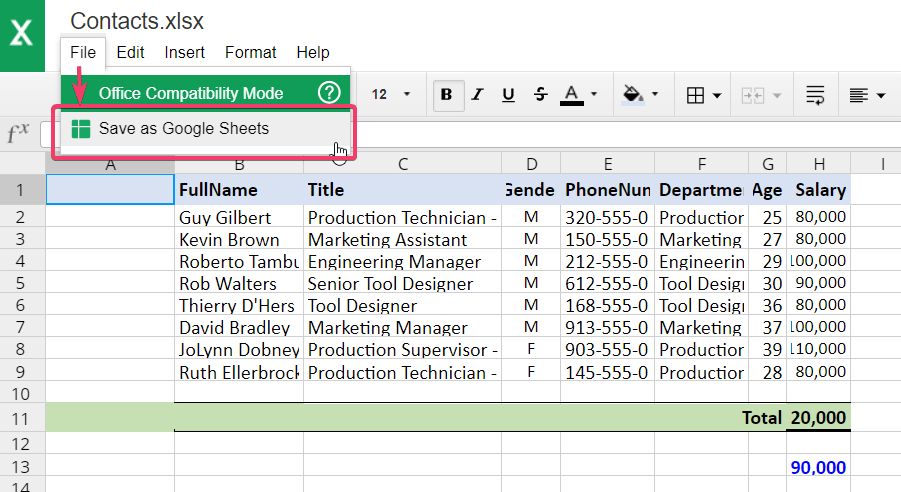5 Ways to Seamlessly Transfer Excel Data to Google Sheets

Exploring the Transition from Excel to Google Sheets

Moving from Microsoft Excel to Google Sheets can offer numerous advantages for collaboration, accessibility, and scalability. Whether you're switching to Google Sheets for its real-time collaboration features or because of its seamless integration with other Google services, understanding how to effectively transfer your data is crucial. Here are five methods to ensure your Excel data seamlessly migrates to Google Sheets, keeping your workflow efficient and your data intact.
1. Direct Upload to Google Sheets

The simplest way to transfer data from Excel to Google Sheets is by using Google Drive:
- Open Google Drive in your browser.
- Click on the "+ New" button and select "File upload."
- Navigate to your Excel file on your computer and upload it.
- Once uploaded, right-click the file in Google Drive and choose "Open with" > "Google Sheets."
Google Sheets will automatically convert your Excel file into a new Google Sheets document. This method ensures that most formatting and formulas are preserved, although some advanced Excel features might not translate perfectly.
2. Import Data into Google Sheets

Google Sheets provides an import feature that can directly pull data from various file formats:
- In Google Sheets, navigate to "File" > "Import."
- Select "Upload" and then click "Select a file from your computer."
- Choose the Excel file you want to import and decide how to replace or insert the data:
- Replace current sheet
- Create a new sheet
- Append to current sheet
This method allows for more control over where and how your data is placed in Google Sheets, making it ideal for incremental updates or merging data from multiple Excel files.
3. Copy-Paste Method

For smaller datasets or when you need to selectively copy data:
- Open your Excel file and select the range you want to transfer.
- Copy (Ctrl + C or Cmd + C).
- Open Google Sheets, select the destination cell or sheet, and paste (Ctrl + V or Cmd + V).
This method is straightforward and maintains the cell values and basic formatting but might lose more complex functions or conditional formatting.
💡 Note: When using copy-paste, ensure you paste as values or check the formulas to see if they've translated correctly into Google Sheets.
4. Using Google Sheets Add-ons

There are several add-ons available that can automate the transfer process:
- Search for add-ons like "Excel Import" or "Sheetgo" from the Google Workspace Marketplace.
- Install the add-on, connect to your Google Drive or cloud storage, and configure the settings to import Excel files.
These add-ons can schedule imports, manage multiple files, and even automate data processing tasks, making them a powerful option for recurring transfers.
5. API Integration for Advanced Users

For those with programming knowledge or those dealing with large-scale data transfers:
- Use the Google Sheets API or third-party libraries like
Google API Client Librariesfor Python orgspreadfor JavaScript. - Develop scripts to automate reading from Excel files and writing to Google Sheets, allowing for complex data manipulation during the transfer process.
This method is not for the faint-hearted but offers unparalleled control over how data is transferred, ensuring consistency and automation in large data migrations.
Key Considerations for Smooth Data Transfer

When transferring data, keep these points in mind:
- Data Integrity: Ensure no data is lost or altered during the transfer. Check for hidden columns, rows, or sheets.
- Formatting: Some formatting might not carry over, so you might need to adjust this manually.
- Compatibility: Certain Excel features like pivot tables or advanced charts might not translate directly to Google Sheets.
- Security: Consider the permissions and sharing settings of the Google Sheet to ensure your data remains secure.
To wrap up our journey from Excel to Google Sheets, these methods offer a spectrum of solutions tailored to different needs and technical competencies. By choosing the right approach, you can leverage Google Sheets' collaborative power, cloud-based access, and integration with other Google services while ensuring your data moves smoothly from Excel. Remember, each method has its place depending on the complexity of your dataset, the frequency of transfers, and the level of automation required.
Can I automatically update Google Sheets with changes from my Excel file?

+
Yes, using add-ons like Sheetgo or scripting with the Google Sheets API, you can set up automatic updates from Excel files stored on your computer or in cloud storage.
What happens to complex formulas when transferring from Excel to Google Sheets?

+
Most common Excel formulas will translate to Google Sheets, but some advanced or proprietary functions might not be available or might work differently in Sheets.
How can I maintain data integrity during the transfer?

+
To maintain data integrity, always verify the transferred data against the original Excel file, especially for large or complex datasets. Using automated tools can minimize errors in the process.